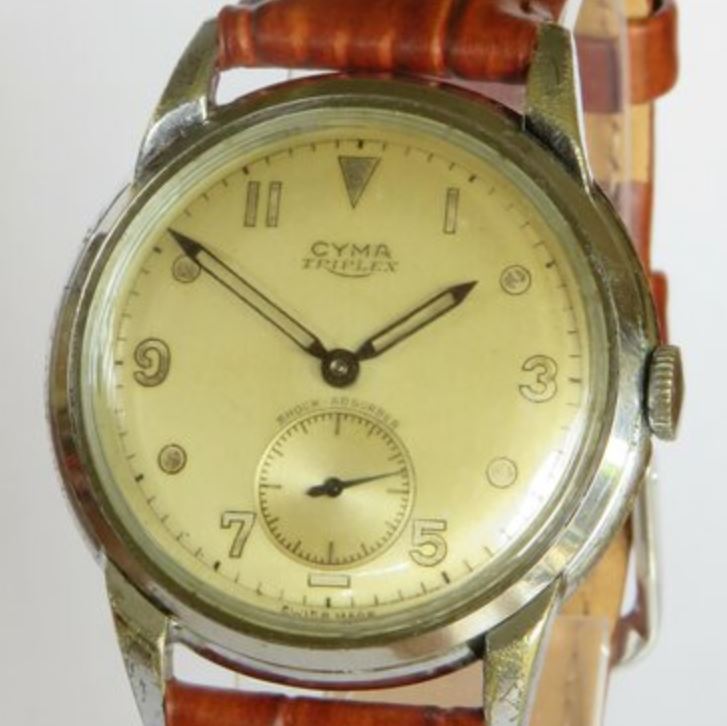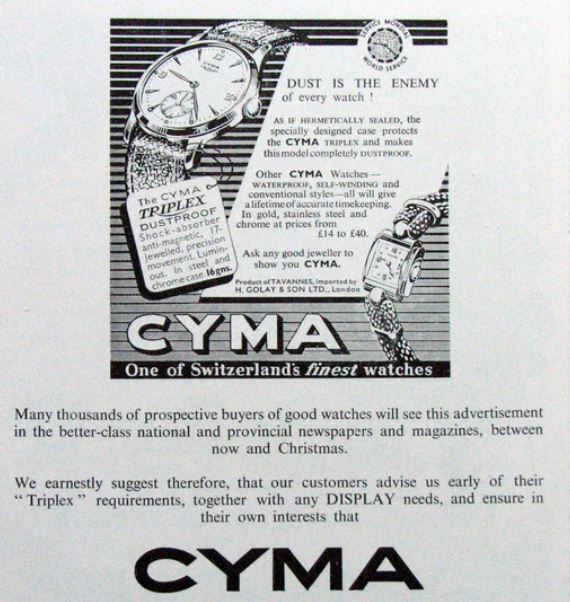Last Updated on August 23, 2025 by Jason
I came across this interesting watch during my endless search for my next vintage timepiece. Its a 1950s Cyma Triplex available at The Vintage Wrist Watch Company (a favourite supplier of mine). I was already familiar with the Cyma brand, as I have had a few pass through my hands over the years. However, I hadn’t come across the “Triplex” before, and I thought I would do a little research. Here is what I have uncovered after many hours trawling the internet.
A brief history of Cyma
Brothers Joseph and Theodore Schwob founded Cyma SA in 1862. Initially known as Schwob Frères, the brothers established an établissage workshop in Le Locle, Switzerland. In 1892, the brothers partnered with a watchmaker called Henri-Frédéric Sandoz, who had created Tavannes, a watch company in the Jura municipality of the same name. Sandoz produced his own watch movements using specialised modern manufacturing methods and machinery (Cyma at Watch Wiki).

There must have been some independence between the two companies, because in 1903, Schwob Frères registered the brand name Cyma. The name “Cyma” derives from the French word “cime,” meaning “summit”. By 1909, the Cyma-Tavannes partnership had 950 employees and was producing 750,000 watches annually. The combined entity became the fourth-largest watch manufacturer globally. Many movements, including this watch’s, bear both “Cyma and Tavannes Watch Co.” signatures.
Water resistance and shock protection
By the 1920s, Cyma had followed the trend of standardising watch part manufacturing and making precision-made components to ensure long-term accuracy. Cyma’s designers and technicians created water-resistant movements as early as 1915 (Tavannes Submarine). During the 1940s, advertising for Cyma’s waterproof cases leaned heavily on the feature, with many ads featuring a partially submerged watch. These were not genuine dive watches, rather water-resistant watches for daily use, suitable for splashing about in the pool or a day at the beach (Cyma at Grail Watch Wiki).
In the late 1930s, Cyma introduced its in-house shock protection system, Cymaflex. During the Second World War, they supplied watches to the British Ministry of Defence, known as the Dirty Dozen. In the 950s, they debuted the Triplex watch case. During the same period, they debuted the Navystar, a robust waterproof watch in a slim-line case. The Cyma and Tavannes brands began to decline during the 1960s, with production ceasing by 1966. That year, ASUAG’s Chronos Holding acquired both companies. Cyma is currently owned by Stelux International, Ltd., a Hong Kong-based holdings firm that invests in fine jewellery and watches (Cyma watches at Wikipedia).
Triplex
This is the interesting part of the research, the “Triplex” case. There were quite a few period advertisements which described the design. The “Triplex” designation refers to a “triple sealed” construction. This sealing occurred at three key points. These were the crown, the crystal, and the screw back. Its primary purpose was protection from dust, shock, and magnetism. The Cyma Triplex was launched in the early 1950s. However, Mikrolisk records that the Triplex trade mark was registered to Schwob Freres & Co. in March 1945. I haven’t been able to pinpoint an exact date, but all of the Triplex watches I have seen online date from the 1950s.

How Triplex works
The Triplex system safeguarded the watch’s movement. It achieved dust protection through triple sealing. Gaskets, typically rubber, sealed the crown. These gaskets sat around the crown stem or inside its tube. Pushing or screwing the crown compresses the gaskets. This creates a tight seal against dust. The watch crystal, likely acrylic, was also sealed to the case. Gaskets, cement, or friction pressure secured it. This tight fit stopped dust and moisture from entering the watch face. Finally, a gasket sealed the screw-on case back. Tightening the back compressed this gasket. This formed a secure barrier against dust and debris.
The Cymaflex system directly protected the delicate balance wheel. It was a protective “cushion” fitted over the balance staff’s pivots to help absorb shocks. The overall case design also contributed to shock protection. Its robust construction absorbed external impacts. This reduced the force transmitted to the internal movement (Cymaflex at Caliber Corner).
Anti-magnetic watches in the 1950s often used a ‘soft iron’ inner case. This inner case, made of mu-metal, surrounded the movement. It acted as a Faraday cage. This diverted magnetic fields around sensitive components. It shielded the movement from magnetic interference. The other option at the time for protecting against magnetism was to incorporate a non-magnetic alloy in the balance assembly. Nivarox, an iron-nickel alloy developed in the 1930s, was an example. It is not clear which of these anti-magnetic solutions is used in the Triplex case.
Calibre 414Ka
This particular watch houses a 15-jewel calibre 414Ka hand-winding movement. It is signed “Cyma and Tavannes Watch Co.”. According to the Ranfft database, the 414 movement was produced from approximately 1940 to 1955. It operates at a frequency of 18,000 beats per hour (vph). The movement boasts a commendable 48-hour power reserve. Its dimensions are 23.7mm in diameter (10.5 lignes) and 3.9mm in height. The “Ka” suffix denotes the inclusion of a shock device, which in this instance is Cymaflex.

Case and dial
The watch measures 33mm in diameter, excluding the winding crown and the lugs. The case is chrome-plated. There is age-related wear and marking to the case, but not too noticeable when the watch is being worn. The back of the watch has a personal inscription from 1953 commemorating a presentation at Digswell Nurseries, Welwyn Garden City. This slightly detracts from the overall value. The lens has a short light scratch, but difficult to see without magnification. The signed dial is in its original finish with original hands (the luminous infill has been removed over the years), a subsidiary seconds dial and outer minute markers. Additionally, the watch includes a ‘new old stock’ strap.
Summary
This 1950s Cyma Triplex wristwatch offers both historical significance and technical merit. The watch has innovative features, like the high-quality Calibre 414Ka movement and the proprietary Cymaflex and Triplex systems. As a result, it would be a desirable, budget-friendly item for vintage watch collectors. A perfect place to start for those new to vintage watch collecting.
Leave a Reply